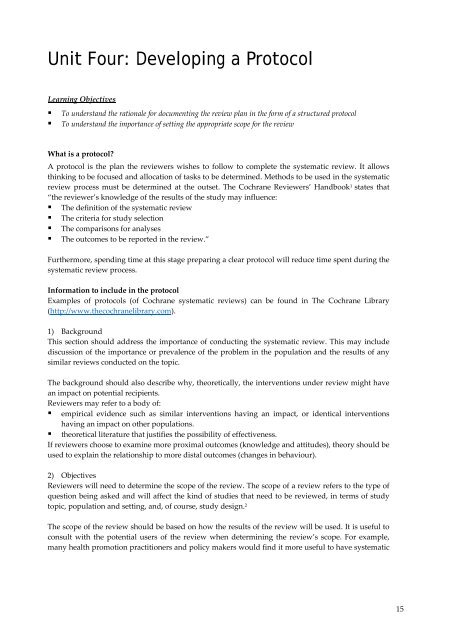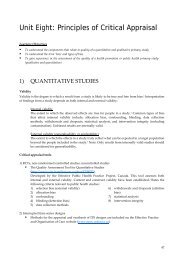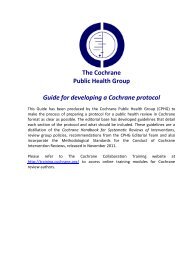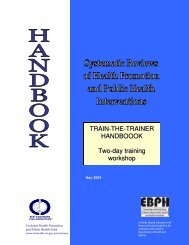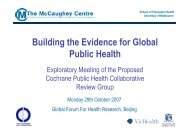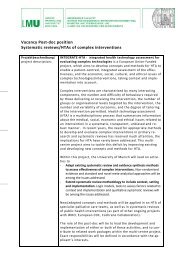Unit Four: Developing a Protocol - Cochrane Public Health Group
Unit Four: Developing a Protocol - Cochrane Public Health Group
Unit Four: Developing a Protocol - Cochrane Public Health Group
Create successful ePaper yourself
Turn your PDF publications into a flip-book with our unique Google optimized e-Paper software.
<strong>Unit</strong> <strong>Four</strong>: <strong>Developing</strong> a <strong>Protocol</strong><br />
Learning Objectives<br />
• To understand the rationale for documenting the review plan in the form of a structured protocol<br />
• To understand the importance of setting the appropriate scope for the review<br />
What is a protocol?<br />
A protocol is the plan the reviewers wishes to follow to complete the systematic review. It allows<br />
thinking to be focused and allocation of tasks to be determined. Methods to be used in the systematic<br />
review process must be determined at the outset. The <strong>Cochrane</strong> Reviewers’ Handbook 1 states that<br />
“the reviewer’s knowledge of the results of the study may influence:<br />
• The definition of the systematic review<br />
• The criteria for study selection<br />
• The comparisons for analyses<br />
• The outcomes to be reported in the review.”<br />
Furthermore, spending time at this stage preparing a clear protocol will reduce time spent during the<br />
systematic review process.<br />
Information to include in the protocol<br />
Examples of protocols (of <strong>Cochrane</strong> systematic reviews) can be found in The <strong>Cochrane</strong> Library<br />
(http://www.thecochranelibrary.com).<br />
1) Background<br />
This section should address the importance of conducting the systematic review. This may include<br />
discussion of the importance or prevalence of the problem in the population and the results of any<br />
similar reviews conducted on the topic.<br />
The background should also describe why, theoretically, the interventions under review might have<br />
an impact on potential recipients.<br />
Reviewers may refer to a body of:<br />
• empirical evidence such as similar interventions having an impact, or identical interventions<br />
having an impact on other populations.<br />
• theoretical literature that justifies the possibility of effectiveness.<br />
If reviewers choose to examine more proximal outcomes (knowledge and attitudes), theory should be<br />
used to explain the relationship to more distal outcomes (changes in behaviour).<br />
2) Objectives<br />
Reviewers will need to determine the scope of the review. The scope of a review refers to the type of<br />
question being asked and will affect the kind of studies that need to be reviewed, in terms of study<br />
topic, population and setting, and, of course, study design. 2<br />
The scope of the review should be based on how the results of the review will be used. It is useful to<br />
consult with the potential users of the review when determining the review’s scope. For example,<br />
many health promotion practitioners and policy makers would find it more useful to have systematic<br />
15
eviews of ‘approaches’ to health promotion (eg. community development or peer‐delivered<br />
interventions), rather than topic‐focused reviews (eg. healthy eating or accident prevention).<br />
The scope is also likely to depend on how much time is available and the likely volume of research<br />
literature.<br />
Lumping the review question, i.e. addressing a wide range of interventions (eg. prevention of<br />
injuries in children):<br />
• likely to be time‐consuming because of the searching and selecting processes<br />
• will better inform decisions about which interventions to implement when there may be a<br />
range of options<br />
• may be ultimately of more use to policy decisions<br />
Splitting the review, i.e. addressing a narrow range of interventions, (eg. prevention of drowning<br />
in toddlers)<br />
• may be less time‐consuming<br />
• will only inform decisions about whether or not to implement narrowly focused<br />
interventions<br />
• may be more useful for practitioners<br />
3) Pre‐determined selection criteria<br />
The selection criteria will be determined by the PICO(T) question, which is described in the following<br />
unit (<strong>Unit</strong> Five. Asking an Answerable Question). It is important to take an international perspective<br />
– do not restrict the inclusion criteria by nationality or language, if possible. 1<br />
4) Planned search strategy<br />
List the databases that are to be searched and if possible, document the search strategy including<br />
subject headings and textwords. Methods to identify unpublished literature should also be described<br />
(eg. handsearching, contact with authors, scanning reference lists, internet searching).<br />
5) Planned data extraction<br />
Reviewers should describe whether they are going to extract process, outcome and contextual data<br />
and state how many reviewers will be involved in the extraction process. The quality assessment<br />
checklists to be used for appraising the individual studies should also be specified at this stage.<br />
6) Proposed method of synthesis of findings<br />
Describe the methods to be used to synthesise the data. For example, reviewers of health promotion<br />
and public health interventions often tabulate the included studies and perform a narrative synthesis<br />
due to expected heterogeneity. It is worthwhile at this stage to consider the likely reasons for<br />
heterogeneity in the systematic review.<br />
Establish an Advisory <strong>Group</strong><br />
Systematic reviews are more likely to be relevant and of higher quality if they are informed by advice<br />
from people with a range of experiences, in terms of both the topic and the methodology. 2 Gaining<br />
significant input from the potential users of the review will help bring about a review that is more<br />
meaningful, generalisable and potentially more accessible.<br />
Preferably, advisory groups should include persons with methodological and subject/topic area<br />
expertise in addition to potential review users.<br />
16
• Establish an Advisory <strong>Group</strong> whose members are familiar with the topic and include policy,<br />
funders, practitioners and potential recipients/consumers perspectives. Also include<br />
methodologists to assist in methodological questions.<br />
• The broader the review, the broader the experience required of Advisory <strong>Group</strong> members.<br />
• To ensure international relevance consult health professionals in developing countries to identify<br />
priority topics/outcomes/interventions on which reviews should be conducted.<br />
• The Effective <strong>Public</strong> <strong>Health</strong> Practice Project has found that six members on an Advisory <strong>Group</strong><br />
can cover all areas and is manageable.<br />
• Develop Terms of Reference for the Advisory <strong>Group</strong> to ensure there is clarity about the task(s)<br />
required. Tasks may include:<br />
• making and refining decisions about the interventions of interest, the populations to be<br />
included, priorities for outcomes and, possibly, sub‐group analyses<br />
• providing or suggesting important background material that elucidates the issues from<br />
different perspectives<br />
• helping to interpret the findings of the review<br />
• designing a dissemination plan and assisting with dissemination to relevant groups<br />
• Develop job descriptions and person specifications for consumers and other advisors to clarify<br />
expectations. Further information, including how to involve vulnerable and marginalised people<br />
in research, is also available at www.invo.org.uk.<br />
An example of the benefits of using an Advisory <strong>Group</strong> in the planning process<br />
A review of HIV prevention for men who have sex with men (MSM)<br />
(http://eppi.ioe.ac.uk/EPPIWebContent/hp/reports/MSM/MSMprotocol.pdf) employed explicit<br />
consensus methods to shape the review with the help of practitioners, commissioners and<br />
researchers.<br />
An Advisory <strong>Group</strong> was convened of people from research/academic, policy and service<br />
organisations and representatives from charities and organisations that have emerged from and<br />
speak on behalf of people living with, or affected by, HIV/AIDS. The group met three times over the<br />
course of the review.<br />
The group was presented with background information about the proposed review; its scope,<br />
conceptual basis, aims, research questions, stages, methods. Discussion focused on the policy<br />
relevance and political background/context to the review; the inclusion criteria for literature<br />
(interventions, outcomes, sub‐groups of MSM); dissemination strategies; and timescales. Two rounds<br />
of voting identified and prioritised outcomes for analysis. Open discussion identified sub‐groups of<br />
vulnerable MSM. A framework for characterising interventions of interest was refined through<br />
Advisory <strong>Group</strong> discussions.<br />
The review followed this guidance by adopting the identified interventions, populations and<br />
outcomes to refine the inclusion criteria, performing a meta‐analysis as well as sub‐group analyses.<br />
The subsequent product included synthesised evidence directly related to health inequalities.<br />
17
REFERENCES<br />
1. Clarke M, Oxman AD, editors. <strong>Cochrane</strong> Reviewers’ Handbook 4.2.0 [updated March 2003].<br />
http://www.cochrane.org/resources/handbook/index.htm<br />
2. Evidence for Policy and Practice Information and Co‐ordinating Centre Review <strong>Group</strong> Manual.<br />
Version 1.1, Social Science Research <strong>Unit</strong>, Institute of Education, University of London, 2001.<br />
ADDITIONAL READING<br />
Silagy CA, Middleton P, Hopewell S. Publishing <strong>Protocol</strong>s of Systematic Reviews: Comparing What<br />
Was Done to What Was Planned. JAMA 2002;287(21):2831‐2834.<br />
Hanley B, Bradburn J, Gorin S, et al. Involving Consumers in Research and Development in the NHS:<br />
briefing notes for researchers. Winchester: Help for <strong>Health</strong> Trust, 2000.<br />
EXERCISE<br />
1. <strong>Group</strong> exercise: Scenario: You wish to conduct a review on one of the following topics:<br />
“Interventions for preventing tobacco sales to minors”<br />
“Workplace interventions for smoking cessation”<br />
“Post‐licence driver education for the prevention of road traffic crashes”<br />
“Primary prevention for alcohol misuse in young people”<br />
“Support for breastfeeding mothers”<br />
“Interventions aimed at improving immunisation rates”<br />
Choose one review. Brainstorm, in small groups, who you might want to include in an Advisory<br />
<strong>Group</strong> for your chosen review. After brainstorming all potential members, try to restrict to 6‐7<br />
members. Remember to keep an international focus.<br />
2. In your own time:<br />
1. Search the <strong>Cochrane</strong> Library for protocols relevant to your area of interest.<br />
2. Familiarise yourself with the essential components of a review protocol.<br />
18
Advisory <strong>Group</strong>s<br />
Setting the scope of your<br />
review<br />
• Policy makers, funders, practitioners,<br />
recipients/consumers<br />
• Make or refine the review question<br />
• Provide background material<br />
• Help interpret the findings<br />
• Assist with dissemination<br />
• Formal (role descriptions) or informal<br />
Lump or split?<br />
LUMP<br />
OR<br />
SPLIT?<br />
• Users needs<br />
• Policy – broad reviews to answer questions<br />
when there is a range of options<br />
• Practitioners – more-specific interventions<br />
or approaches<br />
• Lump – inform which interventions to<br />
implement, more time-consuming<br />
• Split – Yes/No to implement, less time<br />
Lumping or splitting<br />
• Interventions to modify drug-related behaviours for<br />
preventing HIV infection in drug users<br />
• Interventions to modify sexual risk behaviours for<br />
preventing HIV infection<br />
• Interventions to modify sexual risk behaviours for<br />
preventing HIV infection in men who have sex with<br />
men.<br />
• Interventions for preventing HIV infection in street<br />
youth<br />
• Interventions for preventing HIV infection in young<br />
people in developing countries<br />
• Counselling and testing for preventing HIV infection<br />
Writing your protocol<br />
1) Background<br />
• Why is it important?<br />
• How important is the problem?<br />
• Is there uncertainty?<br />
• What is the reasoning as to why the<br />
intervention(s) might work? (include<br />
theoretical frameworks)<br />
• Other similar reviews?<br />
1
Writing your protocol<br />
2) Objectives<br />
• What are the questions/hypotheses?<br />
3) Selection criteria<br />
• PICO(T)<br />
• Population(s)<br />
• Intervention(s)<br />
• Comparison(s)<br />
• Outcomes (Primary / Secondary)<br />
• Types of studies<br />
Writing your protocol<br />
4) Planned search strategy<br />
• Databases and terms<br />
5) Planned data extraction<br />
• Processes and outcomes?<br />
• More than one reviewer?<br />
• Planned quality appraisal (incl. checklists)<br />
6) Method of synthesis<br />
• Tabulate<br />
• Narrative/qualitative synthesis or meta-analysis<br />
2


